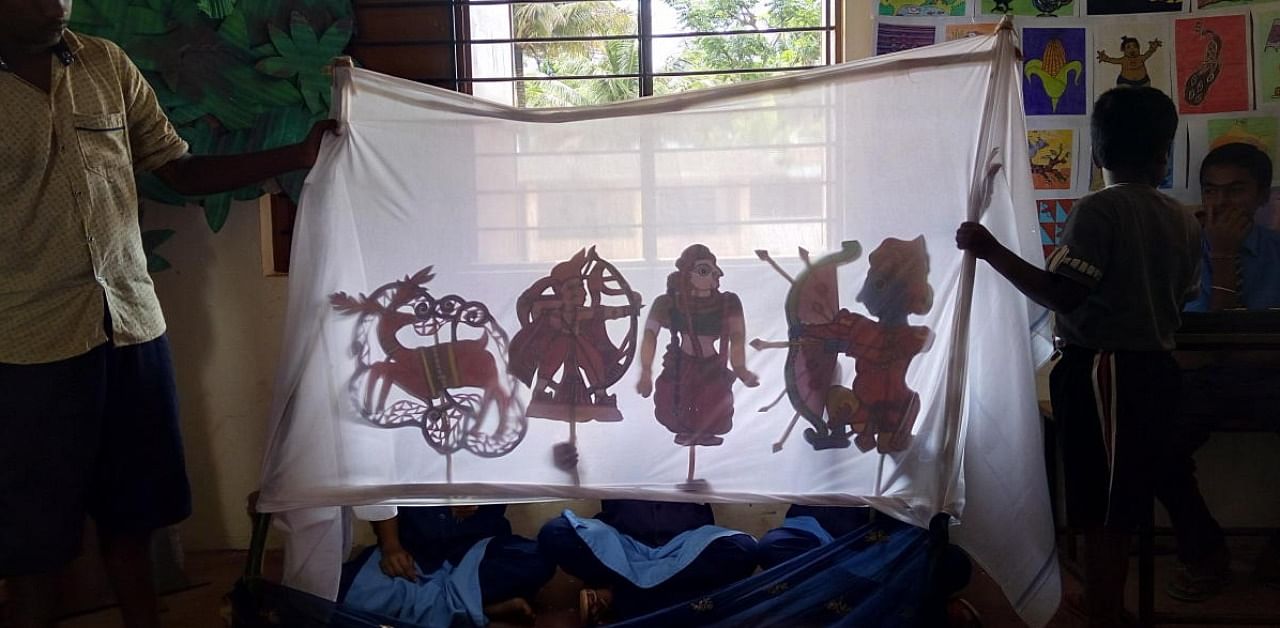Thogalu Gombeyata, which is a form of traditional shadow puppetry, is making a comeback in G B Saragur, a remote village in Mysuru district.
This traditional art form involves movement of leather puppets against light, to create a unique play of shadows. The ancient art form narrates stories of divinity, and tales from the epics Ramayana and Mahabharata are retold to enthrall the audience.
Though shadow puppetry still survives, it has gradually been losing its sheen and there are fewer practitioners of this art form.
As a part of her quest to revive this ancient traditional art, Sangeetha K A, a teacher with G B Saragur government high school in H D Kote, about 45 km away from Mysuru, has trained a group of students. Her students are now empowered to prepare the puppets and conduct the show.
She has guided the students to put on a 30-minute show on Mayamruga, an episode in the Ramayana. Sangeetha also roped in Master Kari Gowda, a theatre personality from the village, to compose the background score and set the music for songs for the show. She also spent her own money to purchase a stand and a white screen needed for the show.
The students have staged several free shows of Mayamruga across the State for the last two years; many of these shows are conducted in association with the Department of Kannada and Culture.
Art of crafting skin
The leather puppets were traditionally crafted from deer skin but with the ban on killing deer, puppets are now made from goat hide now. Parents of two students, Chandan and Charan provide the goat hide to prepare puppets and drums required to generate music.
"Slaked lime (calcium hydroxide) is added to a container filled with water. The goat hide is cut into transparent pieces which are soaked in this water. Once the skin becomes translucent, the pieces are then treated in salt. After the treatment, the pieces are kept for the Sun drying. Finally, these pieces are ready for the artwork," says Sangeetha.
The pieces are further cut into tiny pieces so that ear rings, nose rings chains and other ornaments are clearly visible. Based on tales, different characters such as kings, queens, ministers, chieftains, soldiers and servants are painted on the pieces using attractive colours, she says.
It is believed that lord Brahma created the leather puppetry to entertain Goddess Saraswati. Traditionally, the Killekyata community in north Karnataka and Maharastra practiced this art, according to Sangeetha.
Sangeetha is also an expert in the palm-leaf manuscript. She has mastered the art of readying the palm leaves for manuscript.
"I am trying to introduce the intricacies of the palm-leaf manuscript to the children so that they get an idea of how our ancestors recorded their ideas," she says.
Many students now treat and prepare the leaves for manuscript, she says.
The palm leaves are collected from farmers. They are boiled and kept for the Sun drying. The dried pieces are stitched together so that a canvass is prepared. A needle is used to paint different colours on the leaves.
"My students draw pictures of Puri Jagannath, Krishna, Balaram and Subhadra on these leaves. They also draw pictures narrating childhood tales of Krishna," she adds.
Sangeetha who hails from Karkala, has been conducting drawing exhibitions and art camps since 2000.
She is the recipient of Nalwadi Krishna Raja Wadiyar Seva Bhushan Prashasti, Best Teacher Award and Acharya Kala Puraskara.
Sangeetha's husband Rajesh, also an artist and a recipient of Rajyotsava award, is attempting to revive the long-lost cultural art forms. He has been conducting training for children from low-income communities in Mysuru in the art. He has studied different art forms of Odisha and introduced them to the children in and around Mysuru.
This teacher couple is bringing about changes in the lives of many children. The idea is to bring the best out of rural talent and empower them to find beauty in their life and surroundings.
(Translated by Jagadish Angadi)
